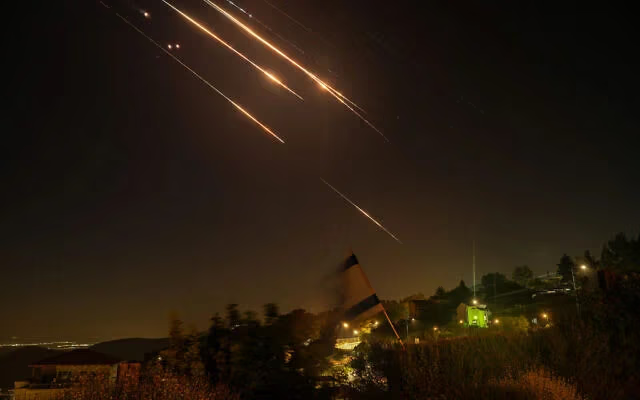In a dramatic escalation of hostilities, Iran launched two barrages of ballistic missiles at Israel early Wednesday, prompting a forceful response from the Israeli Air Force with airstrikes deep into Tehran.
The initial Iranian attack began shortly after 12:40 a.m., when approximately 15 missiles were fired, triggering warning sirens across large portions of Israel. A second volley of around five projectiles followed about 40 minutes later, setting off alerts in central Israeli communities and several settlements in the West Bank.
In advance of the attacks, the Israel Defense Forces (IDF) issued alerts instructing residents to seek shelter. Following each barrage, the military issued announcements declaring it safe to exit bomb shelters. The IDF confirmed that most of the missiles were intercepted by Israeli air defenses.
While no injuries were reported, debris from an interception sparked a fire in a parking lot in central Israel, damaging at least 20 vehicles, according to the Fire and Rescue Service. Officials said the fire was caused by falling fragments, not by a direct missile hit.
The missile attacks came after Iranian Supreme Leader Ayatollah Ali Khamenei declared that “the battle begins” and called for showing “no mercy” to Israelis. “We must give a strong response to the terrorist Zionist regime,” Khamenei posted on his English-language X account. “We will show the Zionists no mercy.”
He also issued a similar post in Hebrew and another in Persian featuring a Shia-themed image referencing Khaybar, the 7th-century battle in which Muslim forces conquered a Jewish settlement. The post depicted a man holding a sword approaching a castle, with fiery trails lighting up the sky above.
Iran’s Islamic Revolutionary Guard Corps (IRGC) claimed the missile barrage was part of what it called “the 11th wave of the proud Operation Honest Promise 3 using Fattah-1 missiles.” In a statement broadcast by state television, the IRGC asserted that Iranian forces “have gained complete control over the skies of the occupied territories.” The group also claimed to have used hypersonic missiles, although Israeli officials deny that Iran possesses such technology.
In addition to the missile fire, warning sirens were activated around the Dead Sea and in several northern communities just before 6 a.m., and again in the Golan Heights shortly after 9 a.m., due to suspected drone activity. The IDF later confirmed it had intercepted six drones launched from Iran—two over the Dead Sea, one over northern Israel, and three in the Golan Heights region.
The overnight assault followed several smaller missile launches throughout Tuesday. The IDF said the scale of attacks appeared to be decreasing, attributing the shift to Iran’s diminished capabilities following earlier Israeli airstrikes.
In response to Wednesday’s missile salvos, the IDF issued an evacuation notice for District 18 in Tehran, warning civilians to leave the area ahead of further military action. Shortly after the alert, the Israeli military launched a fresh wave of strikes targeting Iranian military infrastructure in the capital.
According to the IDF, more than 50 Israeli Air Force fighter jets participated in the operation, hitting approximately 20 sites, including a centrifuge production facility and multiple weapons manufacturing plants. The centrifuge site, the military stated, was part of Iran’s effort to escalate uranium enrichment for the development of nuclear weapons.
The IDF said other targeted locations included facilities producing raw materials and components for surface-to-surface missiles used in the attacks on Israel, as well as systems and components for surface-to-air missiles intended to strike aircraft.






